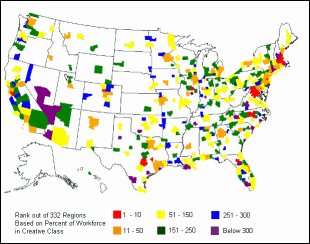
Information, Inspiration, and Ideas for a Sustainable Rural Future
Promoting the Entrepreneurial Community Spirit
Nanocorps in Micropolis: Small Is Good in the Network Economy
Even the U.S. Census Bureau Understands the Implications of the Rise of the Creative Class in our Network Society
Metropolitan and Micropolitan Creative Class Dynamics
 Richard Florida, Carnegie Mellon's distinguished professor of economic development, dramatically shook up the thinking of local government officials and regional planners with the publication of his best-selling book, The Rise of the Creative Class: And How It's Transforming Work, Leisure, Community and Everyday Life. In tROCC (the acronym by which the book and its associated theory are increasingly referenced), Florida cogently and compellingly makes the case that regional economic health comes from the qualities of place, not from a bean-counting preoccupation with traditional benchmarks like the number of multi-national employers, the number of professional sports teams, and the capacity of their stadiums.
Richard Florida, Carnegie Mellon's distinguished professor of economic development, dramatically shook up the thinking of local government officials and regional planners with the publication of his best-selling book, The Rise of the Creative Class: And How It's Transforming Work, Leisure, Community and Everyday Life. In tROCC (the acronym by which the book and its associated theory are increasingly referenced), Florida cogently and compellingly makes the case that regional economic health comes from the qualities of place, not from a bean-counting preoccupation with traditional benchmarks like the number of multi-national employers, the number of professional sports teams, and the capacity of their stadiums.
|
Creative Class Heat In |
|

|
|
|
There is a growing recognition that creative entrepreneurs and networks of small businesses are at the heart of growth and sustainability of local economies. This idea of the power of creative individuals flies in the face of those who think that large corporations are the primary source of jobs and "trickle down" community development. Learn more by reading Carnegie Mellon Professor of Economic Development Richard Florida's latest book, The Rise of the Creative Class. |
When Florida took a detailed look at urban regions that were thriving and those that were dying, he found a new set of key indicators to summarize the qualities of place that productive, creative people value. These key indicators clustered around three core values called the "three T's" – Talent, Technology and Tolerance.
In a work world where the half-life of a job is measured in months rather than years, creative folks care more about where they live than where they work. Talent recognizes and values talent. So not surprisingly, talented, creative people are drawn to areas where there are other talented people. Today's creative class members also value technology, especially broadband Internet access and quality transportation systems that help them live locally and work globally. And perhaps above all, creative folks value a community spirit of tolerance where everyone can be themselves.
Florida states that when the "Three T's" of place come together, we get a high degree of social and economic integration. The Census Bureau definition of metro- and micropolitan areas recognizes the importance of such core-anchored regions. When the mix of Florida's "Three T's" is right, we find healthy, vibrant local economies. When the mix is out of balance, we find stagnation or deterioration.
| Creative Class In The U.S. | |

|
|
|
Where will you find concentrations of members of the Creative Class? The map above shows overall rankings for the top 332 urban regions based on Richard Florida's research. This composite map takes into consideration his Creativity Index, Diversity (Gay) Index, High Tech Index, and Innovation Index. Visit the Creative Class web site for access to all the index maps and tables of raw data.
Image Copyright © 2003 The Richard Florida Creativity Group |
Recognizing the newfound importance of the qualities of place, regional planners and local government officials became hungry for benchmark measures that could help them asses the health of their communities. Richard Florida, through extensions of his research by his consulting practice, The Richard Florida Creativity Group, developed a rigorous assessment methodology and associated indexes to measure regional economic health.
Four indices – the Creativity Index, Diversity (Gay) Index, High Tech Index, and Innovation Index – map the location and extent of Creative Class members in the U.S. (and increasingly international) workforce. These measures have been applied to a diverse range of data, mostly urban areas of at least 50,000 residents or more. The most media-publicized results have been of the "Top Ten" variety – competitive measures between big cities like Boston, San Francisco, Atlanta, and Austin to determine the most creative places.
This focus on cities has two drivers: scale and available data. Just as the brightest stars are most apparent in the night sky, so too have we focused on the state of our major cities to assess our national economic health. To this point, the only available data for such social-economic research was for MSAs, metropolitan statistical areas. Rural areas, small towns and smaller cities were simply a blindspot in the data.

|
|
| The Iowa Department of Cultural Affairs is inviting Iowans to Imagine Iowa 2010. Judging by the response to our tROCCits Workshop, we are certain that Iowa's future will include the creative contribution of these micropolitan areas (recently designated by the U.S. Census Bureau): Boone, Burlington, Clinton, Fort Dodge, Keokuk-Fort Madison, Marshalltown, Mason City, Muscatine, Newton, Oskaloosa, Ottumwa, Spencer, Spirit Lake, and Storm Lake. |
But the Federal Office of Management and Budget and the Census Bureau's recent expansion of its data classification system to include micropolitan regions has redefined the domain of our potential research and application of Creative Class theory. The Census Bureau is, in effect, recognizing the fractal nature of our evolving network economy. That is, micropolitan areas serve the same networking dynamic that such highly urbanized Creative Class hubs as Austin, Atlanta and Boston do for their regional economies.
We might be tempted to simply extend Florida's theory, methods, and indices to this newly available micropolitan data. But doing so would miss an important point. Micropolitan regions, like Havre and the Hi-Line of northcentral Montana, are not just scaled-down versions of our urban metro neighbors. There are qualitative differences as well as quantitative differences as we move from City Life to Country Life. We'll need to extend the theory and tune the benchmark measures to bring the insights of Creative Class theory into rural areas.
At Sohodojo and NARFI, we are addressing this research and social action agenda in the tROCCits Project. We are leading a theoretical and applied investigation into the Rise Of the Creative Class In The Small through a strategic collaboration with The Richard Florida Creativity Group to articulate and explore this important emerging dynamic in our evolving network economy.
The catalyst for this collaboration was the invitation by Anita Walker of the Iowa Department of Cultural Affairs to Richard Florida to headline, and to Sohodojo to present a workshop, at the Creative Economy Unconference. As a counterpoint to and extension of Florida's largely urban and techno-savvy focus, Sohodojo presented Creative Class In The Small: Economic Fire in Rural and Distressed Urban Communities.
In this workshop, we foreshadowed our applied research interests to extend Creative Class theory and indices for application to rural and distressed urban communities – traditional 'outliers' in our network economy. We also predicted that a new class of collaborative, networked small businesses will find a home among the growing and diverse members of the Creative Class.
Now, with the recognition by the U.S. Census Bureau of the importance and network nature of micropolitan areas, we have the data to pursue this important work. Over the coming months, the tROCCits Project will focus on two agendas:
- tuning Florida's indices to map the Creative Class in micropolitan regions, especially in rural areas, and
- prototyping new forms of independent, creative small business organization that are consistent with, and take strategic advantage of, the dynamics of the Creative Class.
-- Page 2 of 3 --
© 2001-2003 North American Rural Futures Institute | Our Privacy Statement
Website design and hosting by Sohodojo, home of the nanocorp

[ Translate page ]
[ Search site ]